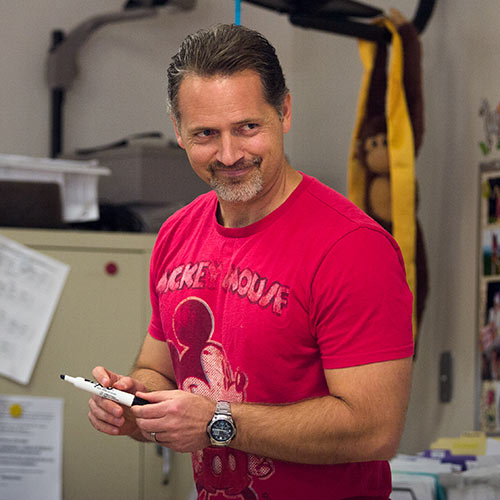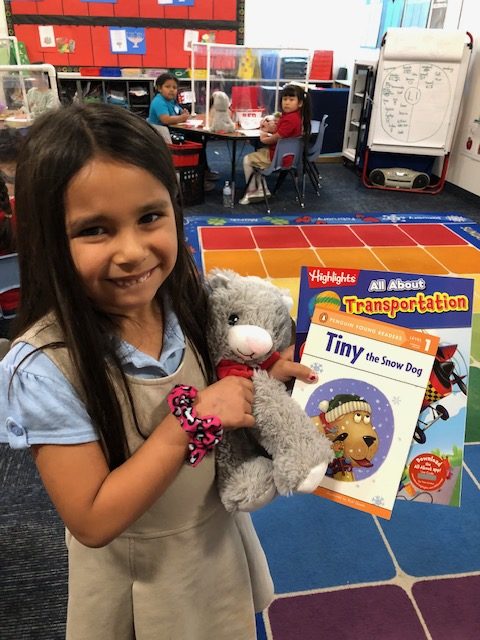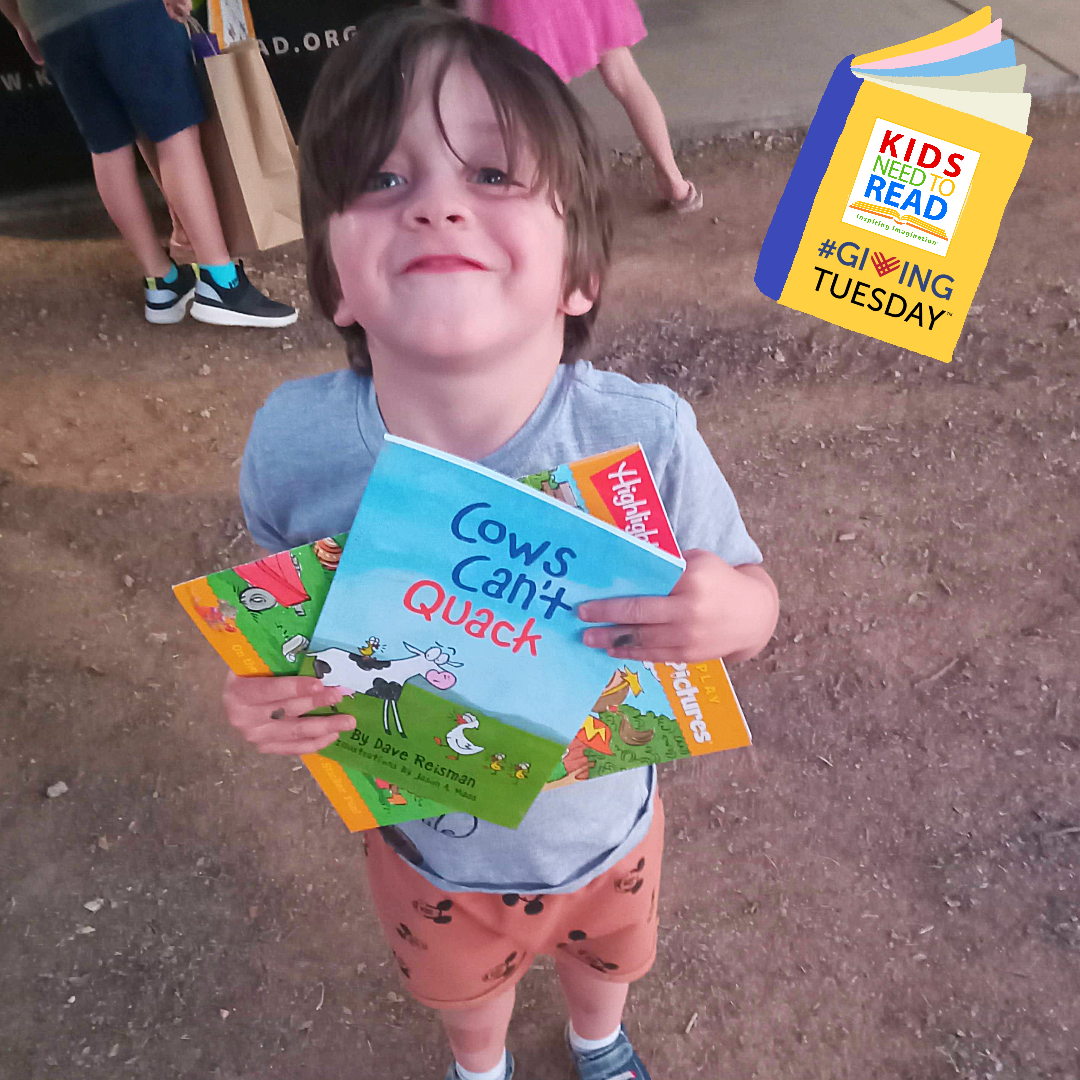By Drew Adams
Photos © Denise Gary
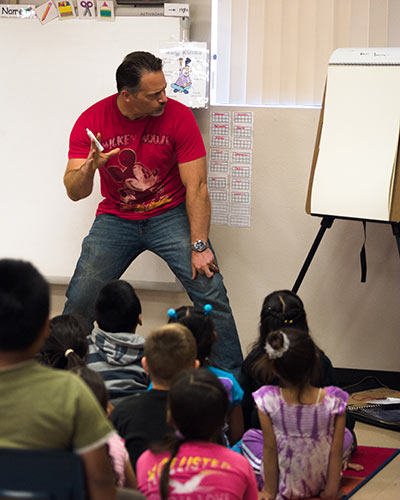
Author and illustrator Steven Riley is no stranger to Kids Need to Read. A frequent collaborator and Phoenix Comicon fixture, as well as the illustrator of KNTR’s The Little Flame, Steven recently came to the Phoenix area to present alongside KNTR and the Arizona Coyotes for various schools and residential home Homeward Bound. Steven took some time to talk more with us about his history with KNTR, how he went from managing restaurants to giving school presentations and illustrating full time, and why Charles Schulz inspired him at a young age. Without further ado, here’s Steven!
Can you tell us how you became involved with Kids Need to Read, as well as your collaboration with Executive Director Denise Gary to create the KNTR book The Little Flame?
I was at my mother-in-law’s house and saw an issue of Parade about stars giving back with Nathan Fillion and a few other actors and actresses on the cover. I’ve been a Nathan Fillion fan since Firefly, so I read the article and found out he was involved in Kids Need to Read. I thought that was kind of interesting because at the time I was going around and doing programs at schools as an author myself, so I went online and found Kids Need to Read. It turned out that what they were doing was really kind of similar to what I was doing. Not so much to give books away—my goal wasn’t to do that, but they were trying to educate kids and get them excited about reading, and that’s kind of what I was doing. I thought, shoot, I should get a hold of these folks.
So I did, I just emailed Kids Need to Read. I figured I’d never hear back from them because they didn’t know me from anybody, but the very next day I got an email back from Denise. We had a conversation and I told her what I did and asked if she was interested at all in seeing a presentation. She said she’d love to, so I lined up a few schools in Phoenix and she came to one and understood what I was trying to do and thought it really fit with Kids Need to Read.
That was six or seven years ago, and from that time on, whenever we could collaborate on things, we did. Mostly that’s been coming to the Phoenix Comicon every year, that’s been the main collaboration we’ve done annually. Probably two years ago, Denise gave me a call and said she’d been thinking about writing this kids’ book for a long time and had finally written it, and was wondering if I’d be interested in illustrating it and I said sure, that’s what I do. So she sent me the manuscript and I thought we could do something with it. Then it was just character design and that kind of thing, and it turns out that as I was doing the art for it, I’d think of something and she’d say it was exactly what she had in mind for The Little Flame. We clicked together on it, and I guess the rest is history.
Why is reading important to you?
Personally, I just enjoy reading. As far as promoting it—especially to kids—it’s the foundation of learning, really, at least in our world today. Reading is it. If a kid knows how to read, if they can learn how to read and they can read well, if they can enjoy reading, if they can get to a place in their life where they read everything, then they’re going to start filling their head with knowledge. They’re going to start learning.
Kids go to school and teachers instruct and try to teach them, but in the end a child learns what they themselves decide to learn. It’s sort of like the old adage: you can take a horse to water, but you can’t make it drink. You can put a kid in school, but you can’t make them learn. If they are reading, if they’re at a place in their life where they enjoy it—this is for anybody, really—then they will do it, and while you’re reading you are absorbing and you’re learning. It’s fundamental, I think, to our society.
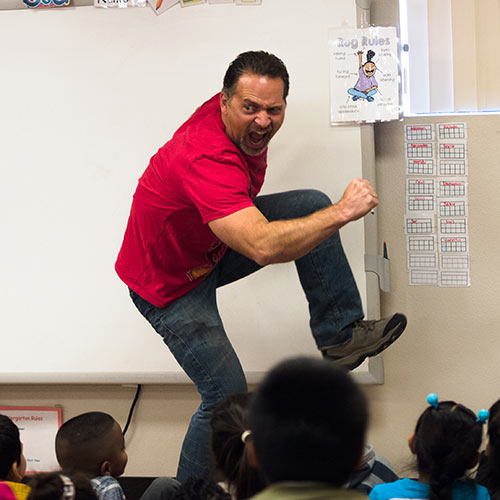
You’re an author and an artist, and your storytelling and Build-a-Book presentations are a unique pairing of the two talents. What was the impetus behind creating this kind of interactive program for kids?
It was really out of necessity. I was living in Yosemite Valley running restaurants. I’d lived there for seven years and had never planned on being a restaurant manager, but it’s just sort of the way my life went. I moved to Yosemite thinking I’d live there for three or four months, maybe a year at most. I did a few things at first, I was a housekeeper in Curry Village and then I was a ski instructor at Badger Pass in the winter. As I approached the time when leaving or staying became something I needed to decide between, I decided I wasn’t ready to leave yet, but I needed a long term job and getting into managing was kind of a natural progression. A buddy of mine said hey, I’ll make you a manager of the pizza place tomorrow. I agreed and became manager of the pizza place, and the hamburger place, and then I became the manager of those two things plus the bar, plus the coffee shop, plus the snack stand. Then I became manager of that plus the buffet and then it was all of Curry Food and Beverage.
I went from being someone who never planned on doing it to managing about 120 people and seven or eight different managers at the height of the season. It was a big job. I ended up doing it for 7 years, and now I had a wife and two kids so I thought this is it, I’m never getting out of managing. I didn’t have a passion for it, though, and I had always been an artist and had always wanted to make a living at art. I had an idea that I could write a kids’ book about Yosemite and use my art to do the illustrations and maybe, if I could get that going, I could make some money with the art. So I did that and, as it turns out, that worked. That was step one.
After that had been going on for a couple of years, a nearby school called me up and said they’d love to have me come and do an author visit. I agreed to it but had no idea what I was going to do when I got there. Out of desperation I developed this idea of teaching the kids how to write a story, and I’d use the group to come up with ideas and show them how to illustrate the ideas that they came up with as we went along. So I threw this idea together and went to the school and did it, and the response was that it was great! They’d never had an author do something like that before. It was an interactive and fun lesson that the kids really got into and I thought okay, maybe other schools would like to do the same thing? I started going out and presenting with other schools and, because of that, some doors opened financially for me that I had not planned on and I was able to retire from the restaurant industry and just do my book promotion and school presentations full time. I think it was in 2006 that my wife and I left Yosemite and moved to Oakhurst, and that’s what we’ve been doing ever since.
Who are some of the writers and artists that inspired you growing up?
As a kid, I loved Dr. Seuss books and I loved Where the Wild Things Are. Dr. Seuss and Maurice Sendak were big influences on me. As a child, my mom always—I mean daily—would read me picture books. There was one called I Wish That I Had Duck Feet. There was one about this weird animal that had spots all over it, but I don’t remember much more. Old Man Wicket’s Donkey was another one, and The Clumpets Go Sailing. I had books that I remember, and I remember the stories and the illustrations even to this day, but my memory was whatever I took in as a four or five year old kid. I didn’t care about who the publishers and authors of these books were; I just thought they were fun stories.
Because he’s so well known and he had so many stories, I knew who Dr. Seuss was. Where the Wild Things Are I knew as a story, it was one of my favorite stories, but I didn’t know who had written it until I was probably 20 and finally went out and said, I might go buy that book that I loved so much when I was a kid. I read it as an adult and could appreciate that this guy actually wrote and illustrated this story. It wasn’t until I was an adult that I necessarily cared about those kinds of things. I guess the work of Maurice Sendak and Dr. Seuss and those others . . . and also Charles Schulz, the Peanuts guy. I remember watching him illustrate on the news or something one night and he was so lightning fast, he would draw Snoopy or Charlie Brown or whatever he was drawing and to this day, I remember just being in awe of how fast he was. As a kid it takes forever to draw anything and Schulz was just flying, creating this stuff in seconds. When I draw Ty Cooney a lot of times, especially in front of kids, I try to go really fast just because I think it’s impressive; I remember how impressive it was when I was a kid. I’ve always not only tried to draw, but tried to draw fast. It stems back from that moment of watching Charles Schulz do that.
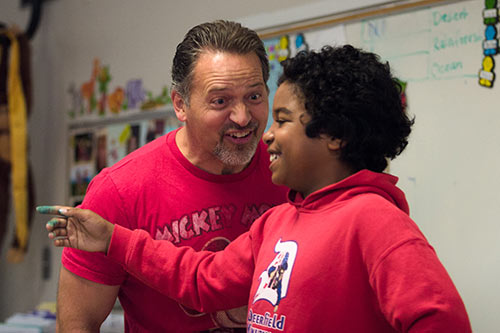
You were in Phoenix in February, presenting at several local schools and organizations, including transition home Homeward Bound. Could you describe those experiences?
Yeah, they were a lot of fun. The beauty of working in the field I’m in is that many adults see the necessity of giving back. They understand that it’s a good thing to do, to give back to the community, and a lot of times that means helping out kids. We gravitate to that; we want to help kids. I think most people have that sense in them, that if there’s something they can do for a child who needs help, then they want to do that. Some of the players and their wives on the Arizona Coyotes decided to try to help some kids and got their whole hockey organization behind that idea. They connect with other organizations that are trying to do the same thing, like Kids Need to Read, and through those kinds of things they decide what to do. They bring in some author and have them present to the kids, let them interact with the kids on a real personal level, give the kids that kind of experience.
I really enjoyed coming out and doing that in February, but I’m not the one that set it up. The Coyotes and Kids Need to Read did the groundwork and asked me later if I wanted to be a part of it. That’s a thrill to me, an honor. It’s a privilege. I was happy to do it, and it was a fun thing to do. The actual event is fun. You go and there are kids and they laugh and it’s fun to hang out with them and to talk with them.
I went to Homeward Bound with the Coyotes and Kids Need to Read, but then Kids Need to Read had me go to three other elementary schools, one of which was sponsored by Pi Beta Phi Phoenix Alumnae Club. These schools were in areas where the median income isn’t very high, and so these kids may not have some of the privileges and advantages that kids from richer areas have. Kids Need to Read focuses on those areas and, when they can, they bring me in. These kids aren’t usually going to get to have that kind of stuff.
What are your thoughts on having national and community organizations like Kids Need to Read, libraries, book fairs, etc., readily accessible to kids?
I think it’s important, especially for those kids like the ones that we saw in February. They’re not going to get exposure to books and author presentations unless you have an organization like Kids Need to Read. I go to schools all over the place and, almost always, the schools that I’m going to are paying me to come. The schools that can afford to have me come present are the schools that have PTAs and have parents that are very involved and have money coming in. Organizations like Kids Need to Read and local libraries are going to essentially step in and make up the difference for those schools that can’t usually afford this type of thing. Kids Need to Read steps in and says, you know, we’ve been raising money just for this and we’re going to bring it to these kids that would otherwise not have something like this. I think it makes a pretty big difference.
These organizations help lessen the gap and allow kids to be on an equal playing field. There aren’t going to be those kids that didn’t get to see this or that didn’t get to have this experience in their life, as well as whatever advantages can come from it, which can be a lot. Like I said, I’ve been influenced greatly by things I saw when I was very young. For kids to get that experience when they’re very young, it can inspire them and give them an idea or goal to shoot for, or some kind of hope that can literally mold parts of the rest of their lives and make them into something later on that they wouldn’t have been otherwise. I think what Kids Need to Read does is pretty significant to those kids that they’re able to touch.
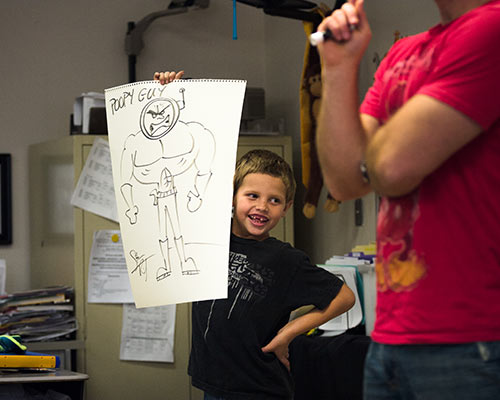
What made you want to be a storyteller, and what words of wisdom do you have for young readers or aspiring young artists?
I’ve always been an artist. I was an artist long before I could write. It was a way to express myself, although I didn’t put it in those terms. I just wanted to draw a picture of a shark and a guy swimming in the ocean or whatever it was, but it was telling a story and as soon as I was able to write, I did start writing stories. I never really thought at the time that I would grow up and do it for a living necessarily, but I just did it because it was fun to do. My kids do it now, they’ll go write and draw pictures. My youngest daughter just showed me some stuff she did yesterday, where she had written a whole page about this picture she drew of a dragon and she wanted to show me, she wanted to share it. I think that’s in all of us, and it definitely was in me. I’ve always written and always drawn, ever since I could write and ever since I could draw, and I’ve always done it really for fun.
That was the thing that inspired me to do it—that it was fun to do, that I enjoyed doing it. A lot of kids don’t know that it’s fun and so they don’t want to do it. Everybody, I think without exception, knows stories are interesting. We watch television, we go to movies . . . those are stories we’re watching. At some point somebody wrote those stories, even though you’re watching it, and I don’t think kids often make that connection. When I come and present, I want the kids to understand that the stories, no matter what they are—whether they’re movies, television shows, cartoons, books—those stories came out of somebody’s brain and they just wrote them down. I want to show kids the fun of doing that. Most of the stories that we do in these school groups are ridiculous, the characters are ridiculous and the stories are ridiculous, and that’s great as far as I’m concerned. The kids are having fun and to me, if the kids have fun, then they’re learning. If they’re bored, their brain shuts off, but if they’re enjoying it and having fun, then they’re learning. Not only are they learning, but they’re learning something that they’re going to remember for a long time.
If someone asked me how they could do what I do, immediately I’d say to do it now. You want to be an author and an illustrator? Start writing stories and start drawing pictures. Do that right now. It doesn’t matter how old you are. Kids have it in their heads that you have to wait to do this kind of thing when you’re an adult and that is simply not the case. Don’t wait, do it now. You write about the things you like and you draw pictures of things you like and you entertain yourself. You are your first critic. Don’t write to please somebody else, write to make yourself happy about it. If you do it and you learn to do it and enjoy doing it, then you’ll do it a lot. If you do it a lot, then you’ll get good at it and, by the time you’re 20, all of a sudden you’re very good at writing and you’re very good at drawing.
Is there anything else—upcoming appearances, new projects, etc.—you’d like our supporters to know about?
I have school presentations I do throughout the year as they come up, so I’m always busy doing that. I usually do presentations in Yosemite National Park in Curry Village every Saturday during the summers, so if anyone is ever in Yosemite on a Saturday, come to Curry Village and see my show or attend my illustration class.
Thanks, Steven, for taking this opportunity to chat with us! Programs like Steven’s are integral to the promotion of thinking creatively and the encouragement of children to read, write, and draw. View more of Steven’s work at his website, where you can also purchase books from his Little Ty Cooney series!
